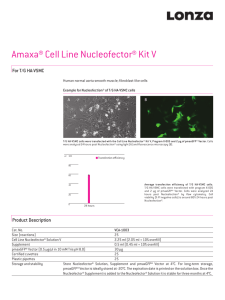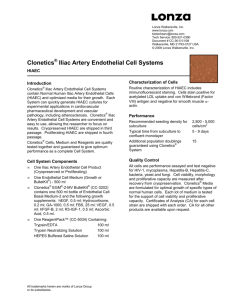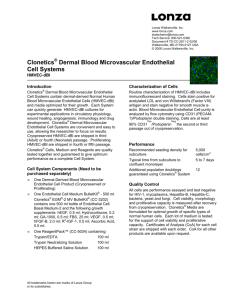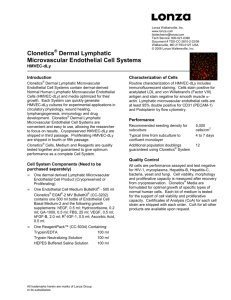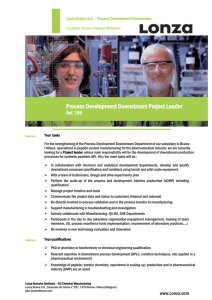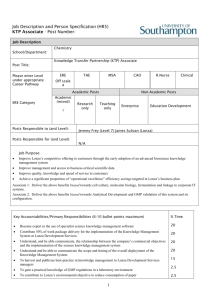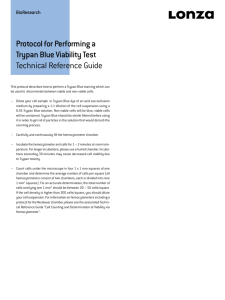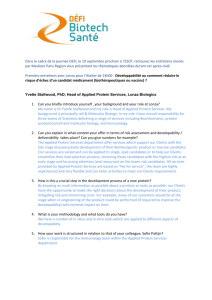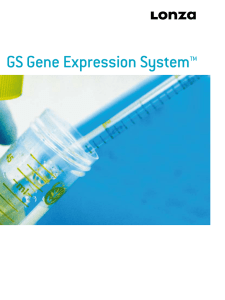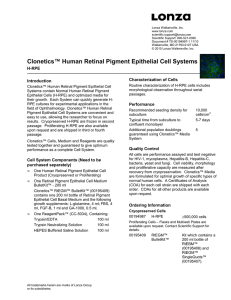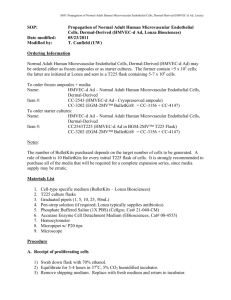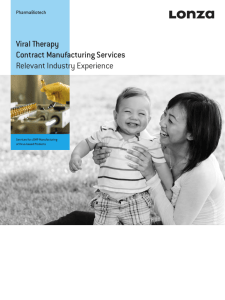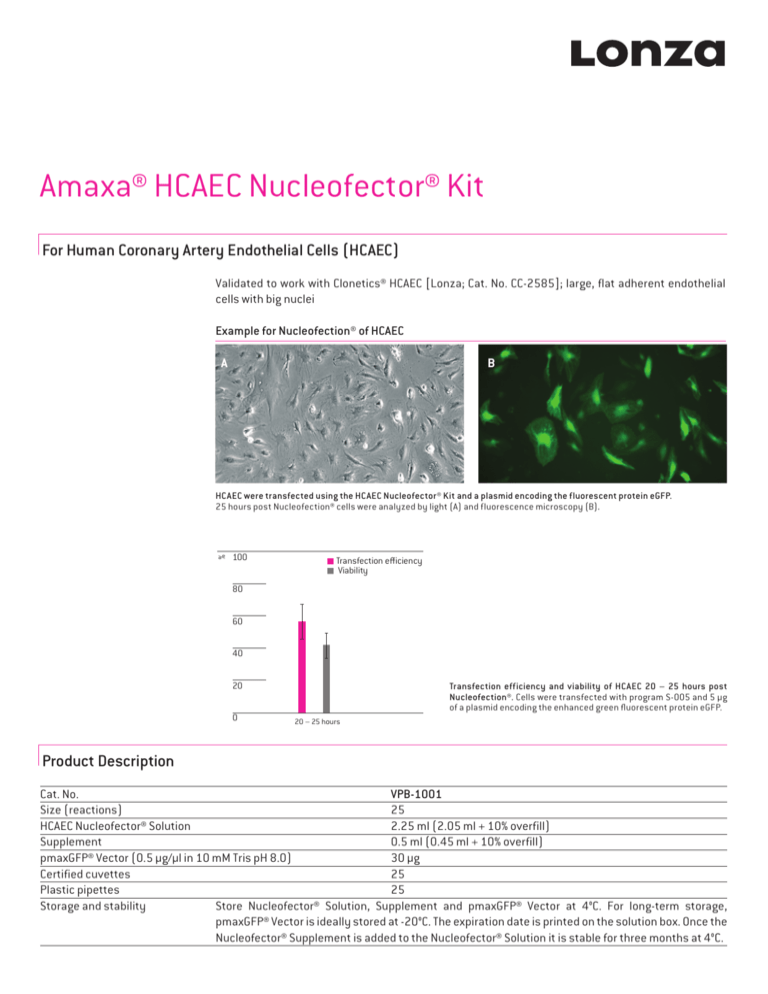
Amaxa® HCAEC Nucleofector® Kit
For Human Coronary Artery Endothelial Cells (HCAEC)
Validated to work with Clonetics® HCAEC [Lonza; Cat. No. CC-2585]; large, flat adherent endothelial
cells with big nuclei
Example for Nucleofection® of HCAEC
A
B
%
HCAEC were transfected using the HCAEC Nucleofector® Kit and a plasmid encoding the fluorescent protein eGFP.
25 hours post Nucleofection® cells were analyzed by light (A) and fluorescence microscopy (B).
100
Transfection efficiency
Viability
80
60
40
20
0
Transfection efficiency and viability of HCAEC 20 – 25 hours post
Nucleofection®. Cells were transfected with program S-005 and 5 µg
of a plasmid encoding the enhanced green fluorescent protein eGFP.
20 – 25 hours
Product Description
Cat. No.
VPB-1001
Size (reactions)
25
HCAEC Nucleofector® Solution 2.25 ml (2.05 ml + 10% overfill)
Supplement
0.5 ml (0.45 ml + 10% overfill)
pmaxGFP® Vector (0.5 µg/µl in 10 mM Tris pH 8.0)
30 µg
Certified cuvettes
25
Plastic pipettes
25
Storage and stability
Store Nucleofector® Solution, Supplement and pmaxGFP® Vector at 4°C. For long-term storage,
pmaxGFP® Vector is ideally stored at -20°C. The expiration date is printed on the solution box. Once the
Nucleofector® Supplement is added to the Nucleofector® Solution it is stable for three months at 4°C.
Optimized Protocol for Human Coronary Artery Endothelial Cells (HCAEC)
Required Material
Note
Please make sure that the entire supplement is added to the Nucleofector® Solution. The ratio of
Nucleofector® Solution to supplement is 4.5 : 1. For a single reaction use 82 µl of Nucleofector®
Solution plus 18 µl of supplement to make 100 µl of total reaction volume.
–– Nucleofector® Device
–– Supplemented Nucleofector® Solution at room temperature
–– Supplied certified cuvettes
–– Supplied plastic pipettes
–– Supplied pmaxGFP® Vector
–– Substrate of interest, highly purified, preferably by using endotoxin free kits; A260 : A280 ratio should
be at least 1.8
–– 6-well culture dish or culture system of your choice
–– For trypsinization: Reagent Pack™ Subculture Reagent Kit containing Trypsin/EDTA, HEPES Buffered
Saline Solution (HBSS) and Trypsin Neutralizing Solution (TNS) [Lonza, Cat. No. CC-5034]. Alternatively
if cells hardly detach: Trypsin 0.5 % – EDTA 0.2 %
–– Culture medium: EGM®-2MV BulletKit® [Lonza; Cat. No. CC-3202]. We recommend storing 40 ml aliquots
of the medium at -80°C. Do not use medium stored for more than two days at 4°C, as this may lead to
reduced cell viability and transfection efficiency
–– Prewarm appropriate volume of culture medium to 37°C (2.5 ml per sample)
–– Appropriate number of cells (5 x 105 cells per sample)
Minimal cell number: 2 x 105 (a lower cell number may lead to major increase in cell mortality)
Maximum cell number: 5 x 105
1.Pre Nucleofection®
Note
Transfection results may be donor – dependent.
Cell culture recommendations
1.1 Seeding conditions: 6 – 8 x 104 cells per flask (25 cm2)
1.2 Replace medium 2 – 3 times per week (2 – 3 ml medium per 25 cm2 flask)
1.3 Cells should be passaged after reaching 70% confluency
1.4 For Nucleofection® cells should be preferably passaged 3 – 4 days before
1.5 Do not use cells after passage number 10 as this may result in substantially lower gene transfer
efficiency and viability
1.6 Optimal confluency before Nucleofection®: 70%
Trypsinization
1.7 Remove media from the cultured cells and wash cells once with PBS; use at least same volume of PBS
as culture media
1.8 For harvesting, incubate the cells 10 minutes at 37°C with recommended volume of indicated
trypsinization reagent (please see required material)
1.9 Neutralize trypsinization reaction with Trypsin Neutralizing Solution once the majority of the cells
(>90%) have been detached
2
Optimized Protocol for Human Coronary Artery Endothelial Cells (HCAEC)
2.Nucleofection®
One Nucleofection® Sample contains
5 x 105 cells
1 – 2 µg plasmid DNA (in 1 – 5 µl H2O or TE) or 2 µg pmaxGFP® Vector or 30 – 300 nM siRNA
(3 – 30 pmol/sample)
100 µl Nucleofector® Solution
2.1 Please make sure that the entire supplement is added to the Nucleofector® Solution
2.2 Prepare 6-well plates by filling appropriate number of wells with 2 ml of supplemented culture media
and pre-incubate/equilibrate plates in a humidified 37°C/5% CO2 incubator
2.3 Harvest the cells by trypsinization (please see 1.7 – 1.9)
2.4 Count an aliquot of the trypsinized cells and determine cell density
2.5 Centrifuge the required number of cells (5 x 105 cells per sample) at 200xg for 10 minutes at room
temperature
2.6 Resuspend the cell pellet carefully in 100 µl room temperature Nucleofector® Solution per sample
2.7 Combine 100 µl of cell suspension with 1 – 2 µg DNA, 2 µg pmaxGFP® Vector or 30 nM – 300 nM siRNA
(3 – 30 pmol/sample) or other substrates
2.8 Transfer cell/DNA suspension into certified cuvette; sample must cover the bottom of the cuvette
without air bubbles. Close the cuvette with the cap
2.9 Select the appropriate Nucleofector® Program S-005 (S-05 for Nucleofector® I Device)
2.10 Insert the cuvette with cell/DNA suspension into the Nucleofector® Cuvette Holder and apply the
selected program
2.11 Take the cuvette out of the holder once the program is finished
2.12 Add ~500 µl of the pre-equilibrated culture media to the cuvette and gently transfer the sample
immediately into the 6-well plate (final volume 2 ml media per well/sample). Use the supplied pipettes
and avoid repeated aspiration of the sample
3.Post Nucleofection®
3
3.1 Incubate the cells in a humidified 37°C/5% CO2 incubator until analysis. Gene expression or down
regulation, respectively, is often detectable after only 4 – 8 hours
Optimized Protocol for Human Coronary Artery Endothelial Cells (HCAEC)
Additional Information
For an up-to-date list of all Nucleofector® References, please refer to:
www.lonza.com/nucleofection-citations
For more technical assistance, contact our Scientific Support Team:
USA /Canada
Phone: 800 521 0390 (toll-free) Fax:
301 845 8338
E-mail: scientific.support@lonza.com
Europe and Rest of World
Phone: +49 221 99199 400
Fax: +49 221 99199 499
E-mail: scientific.support.eu@lonza.com
Lonza Cologne AG
50829 Cologne, Germany
Please note that the Amaxa® Nucleofector® Technology is not intended to be used for diagnostic purposes or for testing or treatment in humans.
The Nucleofector® Technology, comprising Nucleofection® Process, Nucleofector® Device, Nucleofector® Solutions, Nucleofector®
96-well Shuttle® System and 96-well Nucleocuvette® plates and modules is covered by patent and/or patent-pending rights owned by
Lonza Cologne AG.
Amaxa, Nucleofector, Nucleofection, maxGFP, Reagent Pack, EGM and BulletKit are either registered trademarks or trademarks of the Lonza Group
or its affiliates.
Other product and company names mentioned herein are the trademarks of their respective owners.
DPB-1001_2009-06
This kit contains a proprietary nucleic acid coding for a proprietary copepod fluorescent protein intended to be used as a positive control with this
Lonza product only. Any use of the proprietary nucleic acid or protein other than as a positive control with this Lonza product is strictly prohibited.
USE IN ANY OTHER APPLICATION REQUIRES A LICENSE FROM EVROGEN. To obtain such a license, please contact Evrogen at license@evrogen.com.
The CMV promoter is covered under U.S. Patents 5,168,062 and 5,385,839 and its use is permitted for research purposes only. Any other use of
the CMV promoter requires a license from the University of Iowa Research Foundation, 214 Technology Innovation Center, Iowa City, IA 52242.
The use of this product in conjunction with materials or methods of third parties may require a license by a third party. User shall be fully
responsible for determining whether and from which third party it requires such license and for the obtainment of such license.
No statement is intended or should be construed as a recommendation to infringe any existing patent.
© Copyright 2009, Lonza Cologne AG. All rights reserved DPB-1001 06/09
4

